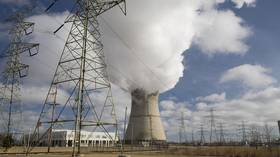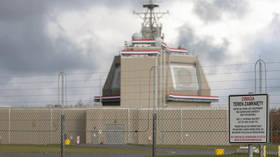Ohio’s $60 million bribery scandal could ensnare the American nuclear sector, because public trust is undermined

Ohio’s $60 million corruption, bribery case – that has ensnared the House speaker and four others – has also embroiled the nuclear power industry, which is at the heart of the criminal charges filed this week.
The nuclear energy sector in the United States has been trying to keep its head above water — unable to compete with cheap shale gas and subsidized wind and solar power. So it has sought help from state governments, which have taken up legislation to reward nuclear for being a carbon-free source of energy. In the case of Ohio, it is home to FirstEnergy, which owns two nuclear power plants in the state and which asked lawmakers for such consideration.
Also on rt.com Cold War ‘nuclear coffin’ leaking radioactive waste from US tests into Pacific Ocean – UN chiefOhio’s lawmakers, like those from Connecticut, Illinois, New York and New Jersey, voted to save their nuclear power plants not just because they are reliable and clean but also because they employ thousands of people. In Ohio, it was a $1.3 billion bailout package. What the citizens of Ohio learned this week, however, is that $60 million in surreptitious payments were allegedly made to make that happen and part of that money went into the pockets of House Speaker Larry Householder.
FirstEnergy Solutions, now known as Energy Harbor, is the nuclear unit within FirstEnergy Corp.
According to the Energy and Policy Institute, this is the company which owned the nuclear assets that Householder helped to bailout “and which FirstEnergy spun off in bankruptcy restructuring.”
Energy Harbor says that it will cooperate fully with the investigators, although it is not named in the criminal complaint. However, it is likely the entity that prosecutors refer to as ‘Company A’ — the one that made the $60 million in payments to Speaker Householder’s ‘Generation Now’ fund so that it could get the $1.3 billion in benefits. Prosecutors say that the money was paid over a three-year time frame beginning in 2017.
Also on rt.com Pentagon hands out contracts for PORTABLE nuclear reactors... yet another gold vein for cash-savvy military?“This is likely the largest bribery, money laundering scheme ever perpetrated against the people of the state of Ohio,” US Attorney David DeVillers told a press conference. “This was bribery, plain and simple. This was a quid pro quo. This was pay to play.”
In the actual complaint, the prosecution alleges the payments were tantamount to “bags of cash” that went unregulated and unreported.
This is more than a public corruption scandal. It is a potential take-down of nuclear energy. If it is, the ramifications would be huge: According to the Nuclear Energy Institute, there are 96 nuclear reactors in 29 states. Altogether, they supply about 20 percent of the country’s electricity and about 55 percent of its carbon-free power. They operate at 92 percent capacity, more than any other type of power plant.
A heavy weight
Context is key. In the US, electricity grid operators are the ones to order up and dispatch the lowest-cost electricity sources — a system that invariably favors shale gas because it is so cheap relative to competing fuels. Existing generators that sell their electricity at market rates, can’t win. This fact, along with the high capital costs it takes to construct nuclear plants, has severely curtailed nuclear development in the US.
As a result, six nuclear plants have closed down since 2013 and several more have announced retirement dates over the next decade. The practical implications of moving away from nuclear and into natural gas have been greater CO2 emissions. When Southern California Edison closed its plant in 2013, such heat-trapping releases rose by 35 percent. To avoid further closures, state legislatures are subsidizing nuclear power by recognizing their carbon-free contributions.
Also on rt.com US govt regulator ‘complicit’ in radioactive leak at S. Carolina plantBut the American nuclear power sector has never learned the most basic lesson of Three Mile Island Nuclear Generating Station, which suffered a partial meltdown of its core in 1979 and which triggered an irrevocable backlash: get accurate information to the public in a timely manner. Secrecy does not work. In 2013, Southern California Edison said it would shutter its San Onofre Generating Station because of a small radiation leak. While the utility had maintained publicly that it only learned of the seepage in 2012 during routine maintenance, it was subsequently proven that it long knew that irregular vibrations could lead to leaks.
The utility then lost all credibility with regulators and the public.
Bad economics in combination with poor PR have been mounting for a long time. And the problems are bound to get worse now that FirstEnergy’s Energy Harbor is allegedly embroiled in this latest mess. And the industry can’t blame the environmental movement for this latest crisis — a movement concerned about storing radioactive nuclear waste and potential accidents.
“FirstEnergy’s successful campaign last year to secure a $1 billion bailout of its Ohio nuclear plants is at the center of a pay-to-play scandal that is rocking Ohio,”says Sandy Buchanan and Seth Feaste, of the Institute for Energy Economics & Financial Analysis. “The FBI would do well to take a closer look at all other state government-official involvement with FirstEnergy during the years when FirstEnergy was seeking a ‘legislative solution’ to save its nuclear plants.”
Where does the nuclear sector go from here? No doubt, the industry will separate itself from the corruption scandal now plaguing the state of Ohio. It will continue to maintain that global climate goals cannot be met without heavy participation from nuclear. But it will once again have to fight off the stench of secrecy and back-room politics — the same factors that have weighed it down since 1979. When the Ohio case is resolved, so too might be nuclear’s future in the US.
Also on rt.com Feds sue Lockheed Martin for kickbacks & fraud in Hanford nuclear site clean-up contractsIf you like this story, share it with a friend!
The statements, views and opinions expressed in this column are solely those of the author and do not necessarily represent those of RT.













